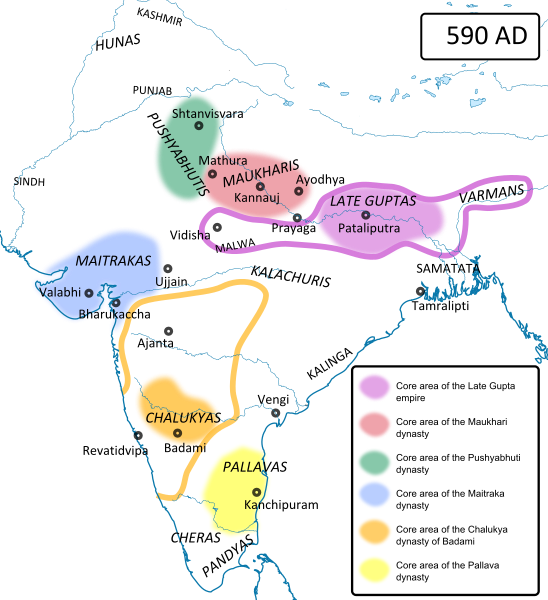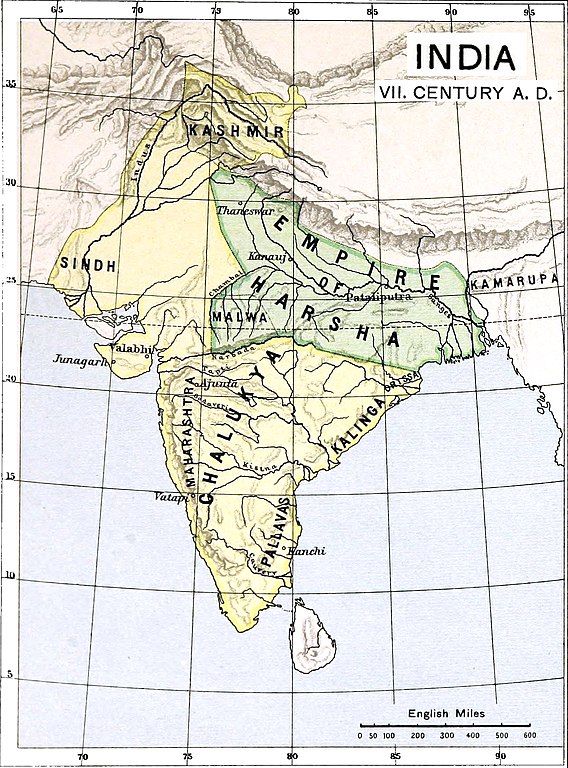
| PUSHYABHUTI DYNASTY Vardhan dynasty :
6th century – 7th century
The
Empire of Harsh at its maximum extent. (Bottom map)
Capital
: Sthanvishvara (modern Thanesar) Kanyakubj (modern Kannauj)
Preceded by
• Later Gupta dynasty
• Gaud Kingdom
Succeeded by
• Gurjar-Pratihar dynasty
• Chalukya dynasty
The vardhan dynasty, also known as the Pusyabhuti dynasty, ruled parts of northern India during 6th and 7th centuries. The dynasty reached its zenith under its last ruler Harsh-Vardhan, whose empire covered much of north and north-western India, and extended till Kamrup in the east and Narmada River in the south. The dynasty initially ruled from Sthanvishvar (modern Thanesar, Haryana), but Harsh eventually made Kanyakubj (modern Kannauj, Uttar Pradesh) his capital, from where he ruled until 647 CE.
Etymology
and name :
Some modern books describe the dynasty as "Vardhan", because the names of its kings end with the suffix "-vardhan". However, this may be misleading as the names of kings of other dynasties also end with this suffix.
Origins
:
The Pushyabhuti mentioned in Bana's account appears to be a fictional character, as he is not mentioned in the dynasty's inscriptions or any other source.
History
:
According to the Harshcharit, after Prabhakar's death, the king of Malav attacked Kannauj, supported by the ruler of Gaud. The Malav king killed Grah-Varman, and captured Rajyashri. Bana does not mention this king, but historians speculate him to be a ruler of the Later Gupta dynasty. Prabhakara's elder son Rajya-Vardhan defeated the Malav ruler, but was killed by the Gaud king.
The Harshcharit further states that Prabhakara's younger son Harsh-Vardhan then vowed to destroy the Gaud king and their allies. Again, Bana does not mention the name of the Gaud king, but historians identify him with Shashank-Dev, a Maukhari vassal (mahasamant). Harsh formed an alliance with Bhaskar Varman, the king of Kamrup, and forced Shashank to retreat. Subsequently, in 606 CE, Harsh was formally crowned as an emperor. He captured a large part of northern India. There are different assessments of the exact extent of Harsh's empire, but he controlled major parts of northern India; his overlordship was accepted by the king of Vallabhi in the west and the Kamrup king Bhaskaravarman in the east; in the south, his empire extended up to the Narmada River.
Harsh eventually made Kanyakubj (modern Kannauj in Uttar Pradesh) his capital, and ruled till c. 647 CE. He died without an heir, leading to the end of the Pushyabhuti dynasty.
Rulers :
Coin of Harshvardhana, circa 606-647 CE The following are the known rulers of the Pushyabhuti or Vardhana dynasty, with estimated period of reign :
•
Pushyabhuti, possibly mythical
Source :
https://en.wikipedia.org/ |


